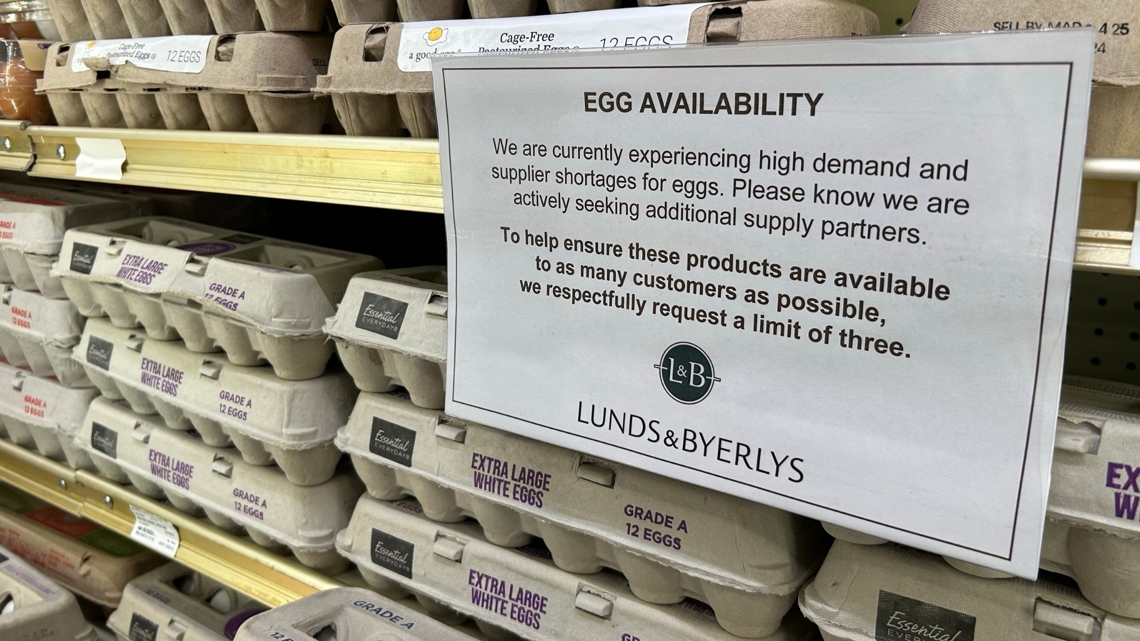
A University of St. Thomas professor said it might take months for the poultry population to return to a normal population.
MINNEAPOLIS — No one is egg-cited about the price of eggs, especially if you work in a bakery.
“It’s paramount to what we do. We have to buy them,” said Hold The Wheat bakery Manager Rich Surprise.
The family-owned bakery specializes in gluten-free sweets with vegan options. Surprise said the products they purchase are more expensive since they’re a specialty bakery, but the price of eggs has caught their attention.
“We’re looking at the bottom line every single week, every single day, so when something goes up 10%, 20%, it’s sort of eye-opening,” he said. “We’re going through about five cases of 75 dozen eggs, 80 dozen eggs, in any given week, come holidays we’re probably doing almost twice that.”
According to the consumer price index, egg prices increased 38% last year. The average cost for a dozen eggs to is $3.65, $1.50 more than in 2023.
And it might be a while before grocery store egg prices come down.
A few factors play into this, but one that’s spreading is the bird flu.
“What we’re seeing now is challenges arising out of California that are really struggling with the number of cases of highly pathogenic avian influenza that they’re having in their egg industry locally,” said Poultry Educator Abby Schuft at the University of Minnesota Extension.
She said it’s why egg prices out West are more expensive. Schuft said the virus has been around for three calendar years, entering its fourth.
“There’s been so many ebbs and flows as the disease has been affecting various poultry flocks,” she said.
Schuft said Minnesota hasn’t been hit like California, but we may start to see the impact.
“We will start seeing that wave of effect because our suppliers that supply us locally and in the western metro… and maybe those that are closer to those in California are having to sort of re-direct where their supply can go,” Schuft said.
She said the bird flu is still a problem because the virus is learning.
“Viruses change and adapt for their own survivability and the same thing is happening with this H5 virus that has been circulating our poultry herds and now has modified and changed itself to be able to infect dairy herds,” she said.
Operations and Supply Chain Management Professor Kyle Goldschmidt said Texas and Michigan have also reported large-scale outbreaks. This has led to millions of chickens being culled as a result of the virus. He said an entire flock can be culled over a single outbreak, which has reduced the number of laying hens available.
He also said there are seasonal factors. He said egg production declines in the winter because of shorter daylight hours.
Goldschmidt said it could take several months to rebuild the poultry population, and it could be extended if more flocks are culled.
Schuft said even though it feels like there’s a shortage, we’re not entirely there yet.
“We’re not necessarily in a shortage, we’re just not as flush as an industry because we have to be able to kind of step in and help those producers and suppliers fill the grocery stores,” Schuft said.
However, eggs aren’t always easy to find.
“We’re still purchasing the same number; we might jump between vendors. We’ve had some vendors. We’ve had some vendors where you can’t necessarily get the eggs when you need them, so you have to jump to another vendor,” Surprise said.
Surprise said they’ve tried new things to offset the cost. They have an in-store freezer filled with “take and bake” to-go items, they’ve expanded their menu to give customers more options, and they’ve added little sauces to go with different items.
He’s hopeful the prices will eventually come down.
“It’s just something over the long term we hope that the prices will decrease but right now it’s just one of those things we’re keeping a close eye on,” he said. “An unfortunate part of the business. We just take that cost; we eat that cost. We’re not raising prices here. We don’t want to put that onto the customer.”
